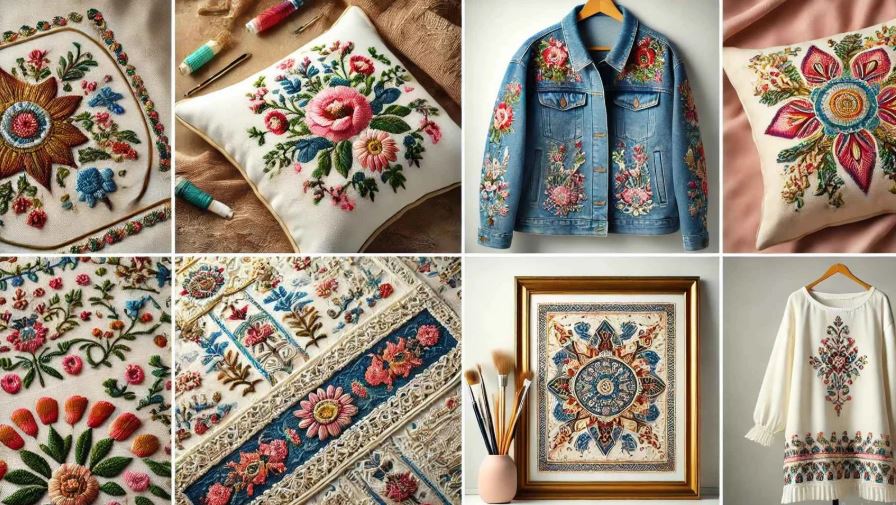News
Embroidery Across Borders: Comparing Embroidered Shirts from Different Cultures
Embroidery Across Borders. Embroidery is more than a decorative art—it’s a living tradition that reflects the identity, history, and beliefs of its people.
From vibrant floral motifs in Eastern Europe to minimalist Japanese patterns, embroidered shirts are a beautiful expression of cultural heritage.
In this post, we’ll explore and compare embroidered shirts from five distinctive cultures: Mexico, Ukraine, Japan, India, and Nigeria.
1. Mexico – Otomi and Tenango Embroidery
Style: Bold, colorful, nature-inspired
Techniques: Hand-stitching, satin stitch
Cultural Significance:
Mexican embroidered shirts, especially those from the Otomi and Tenango regions, are famous for their vivid colors and symbolic motifs.
Animals, flowers, and abstract shapes dominate the design, often stitched on white cotton shirts.
Traditionally made by Indigenous women, these patterns tell ancestral stories passed down for generations.
Modern Usage:
These shirts are often worn at festivals and celebrations and have become popular globally in boho and folk-style fashion.
2. Ukraine – Vyshyvanka Shirts
Style: Geometric patterns, red and black color schemes
Techniques: Cross-stitch, openwork
Cultural Significance:
The Vyshyvanka is a traditional Ukrainian shirt known for its intricate embroidery, which varies by region. Red symbolizes love and passion, while black may represent sorrow or the earth.
Each symbol has meaning—stars for protection, spirals for eternity.
Modern Usage:
Worn proudly on Vyshyvanka Day and national holidays, these embroidered shirts are a symbol of national pride and identity.
3. Japan – Sashiko Stitching
Style: Minimalist, geometric, often white-on-indigo
Techniques: Running stitch (Sashiko)
Cultural Significance:
Originally used as a method of mending clothes in rural Japan, Sashiko developed into an aesthetic embroidery style. The patterns—waves, mountains, and grids—symbolize harmony and resilience.
Unlike more decorative styles, Sashiko emphasizes functionality and wabi-sabi (the beauty of imperfection).
Modern Usage:
Now popular in streetwear and artisanal fashion, sashiko shirts offer a clean and sophisticated look that blends tradition with modern minimalism.
4. India – Chikankari and Phulkari Work
Style: Delicate floral or bold colorful motifs
Techniques: Backstitch, chain stitch, herringbone stitch
Cultural Significance:
India offers a rich diversity of embroidered shirt styles. In the north, Phulkari (meaning “flower work”) features bright, colorful patterns stitched on coarse cotton.
In contrast, Chikankari, from Lucknow, uses fine white embroidery on lightweight fabrics like muslin, symbolizing elegance and grace.
Modern Usage:
Chikankari kurtas are worn at formal events and weddings, while Phulkari shirts are a staple in Punjabi celebrations and folk dances.
5. Nigeria – Aso Oke and Yoruba Embroidery
Style: Abstract, often metallic or high-contrast threadwork
Techniques: Hand or machine embroidery on woven fabric
Cultural Significance:
In Yoruba culture, embroidered shirts like Agbada or Danshiki feature rich, symbolic embroidery often denoting status and lineage.
Gold or silver thread adds a regal touch, and designs are custom-tailored for events such as weddings or naming ceremonies.
Modern Usage:
Nigerian embroidered shirts remain a powerful form of cultural expression, blending tradition with contemporary African fashion.
Conclusion
Embroidered shirts are more than garments—they’re wearable stories. Each culture uses fabric and thread to convey messages of identity, history, and beauty.
Whether it’s the bold symbolism of Ukrainian vyshyvanka or the minimalist precision of Japanese sashiko, these shirts connect us to the diverse threads of global heritage.
Looking to add culture to your closet?
Explore hand-embroidered shirts inspired by these global styles for a look that’s as meaningful as it is fashionable.


